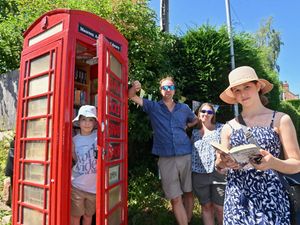How New Year is celebrated around the world
Happy New Year, Bonne année, Feliz año nuevo, Szczesliwego Nowego Roku. However you say it, we will soon be ringing in the new year and wondering what 2020 will bring.
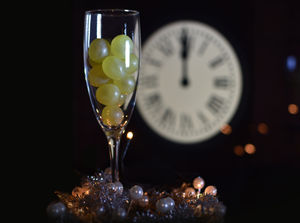
While we’re all dancing the night away at a party or watching Jools Holland’s Annual Hootenanny on TV, how does the rest of the world celebrate? We take a look at how New Year is marked around the globe . . .
Eat 12 grapes at midnight – Spain
When the clocks strike midnight on New Year’s Eve in Spain you will find many people stuffing 12 green grapes in their mouths in an attempt to ward off bad luck in the new year.
They eat one for each stroke of midnight to have a lucky and prosperous year ahead but anyone who fails to finish their grapes by the time the clock stops chiming should be prepared to face 12 months of misfortune.
A common story traces the story of the twelve lucky grapes, or uvas de la suerte, to grape farmers in Alicante, Spain, who cannily suggested the idea when they had a surplus harvest to unload in the early 1900s.
But some people believe it dates back further and it developed from Madrid’s bourgeoisie copying the French custom of drinking champagne and eating grapes on New Year’s Eve in the 1880s.
Over time the tradition eventually became a superstition that also spread to Central and South America and now very few Spaniards will be found skipping the grapes in the count down to the new year.
While many people eat their grapes at home, plenty of Spanish squares, bars, and restaurants fill with people eating grapes at midnight on New Year’s Eve.
Thousands of people meet at the Puerta del Sol, the equivalent of Trafalgar Square in London or Times Square in New York, to see in the New Year, singing, dancing and, of course, eating their 12 grapes and downing their glasses of bubbly.
Scarecrow burning – Ecuador
As the clock strikes midnight in Ecuador communities gather to around fires to burn effigies of politicians, pop culture figures, and other icons of the year in streets.
This tradition of burning the “Año Viejo”, or old year, is said to be a symbolic of cleansing the bad from the previous 12 months before the new year commences.
It’s believed to date back to an 1895 yellow fever epidemic that hit Guayaquil especially hard and saw people packing coffins with the clothes of the dead and setting them alight in an act that was both a symbol as well as a purification rite.
Today it’s become a widespread tradition and celebration and the scarecrow-like dolls being burned are much more light-hearted and elaborate, with some towering effigies vividly painted and paraded through the city.
Guayaquil has become famous for its “monigotes”, super-sized Años Viejos and there is an annual competition for the best with tours also organised so that people can see the creative efforts around the city.
The construction of these dolls is a popular family activity, and includes filling old clothing with sawdust and newspaper until an eerily human-like body shape is formed.
Often they are modelled in the shape of friends and family and burned to induce luck and prosperity.
Any thrillseekers wishing to increase their chances of a better year to come can even jump into the flames 12 times for each month for good luck.
Smashing crockery – Denmark
The Danes know how to have a smashing good time. It’s Queen Margrethe’s New Year’s Eve speech, broadcast live from Fredensborg Castle that signals the beginning of a night of festivities.
And it’s long been a tradition to round up all your broken bits of china and smash them against your friends’ door in a sign of affection and ever lasting friendship.
Throughout the year, rather than throwing away their broken plates or bowls, families will put them to one side ready for the last night of the year.
It’s also said to bring good luck and the more broken plates you have, the more good fortune you can expect to come your way. Some also some say the ritual is also a means of leaving any anger, aggression and ill-will behind before the New Year begins
Rather than flinging them at the door, children sometimes place a little pile of chipped dishes on their neighbours’ doorsteps to bring them good luck in the 12 months to come.
On New Year’s Eve, Danes will also enjoy a traditional meal of boiled cod, typically served with home-made mustard sauce and all the trimmings.
It will be followed by a Kransekage which is a towering cake made from layer-upon-layer of marzipan rings.
The cake’s turret-like shape is reminiscent of a cornucopia, the horn of plenty, which promises happiness and wealth for the coming year.
Hanging onions – Greece
After attending a New Year’s Day church service, many Greeks will find an onion to bring home and hang up for good luck.
They believe onions are a symbol of good health, fertility, and longevity and having them in their house will ensure make sure the new year is filled with many blessings.
The wild onion that grows on the island of Crete looks like a big onion. If you uproot it, it will still grow new leaves and flowers and people believe this rare quality signifies great natural power and they hang wild onions in their homes on New Year’s Day.
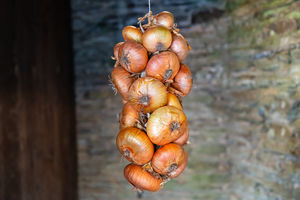
The pomegranate is a symbol of abundance, fertility and good luck. In many areas of Greece they hang a pomegranate in their home in autumn and after the New Year’s Eve church service, they smash it at the door while wishing everybody a Happy New Year.
New Year’s Eve is also a day when Greeks try their luck. They believe that if they win playing cards or the lottery, they will have good luck all year long. Lotteries and card games at home or in clubs and coffee shops are ongoing when the year turns.
In the Cyclades islands, it is considered a good omen to have north winds on New Year’s Day. If a dove lands in the yard that day, it brings good luck. But if a crow flies over a house, then it is a bad omen for the new year.
Lead pouring – Germany
In Germany, all of the New Year’s Eve celebrations centre around the tradition of Bleigießen, or lead pouring.
Families and friends will gather around and, using the flames from a candle, each person melts a small piece of tin or wax and pours it into a container of cold water. The shape that the tin or wax forms is said to reveal a person’s fate for the upcoming year. An island shape means a dream will come true, a heart stands for happiness, health and peace, a nest represents luck within the family, a mushroom means you could be lucky in love and an arrow is said to be the message that you will find the right way.
It’s said that the ancient Greeks and Romans performed this kind of fortune telling, known as Molybdomancy in English.
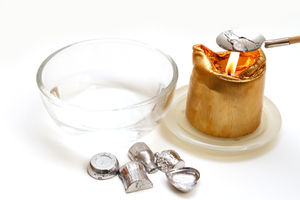
Other New Year’s Eve traditions include using a pendulum to answer yes-or-no questions or opening the Bible to a random page in order to predict the future. In the spirit of bringing luck to the new year, lucky charms in the form of pigs, clover, ladybugs, and horseshoes are sometimes exchanged between friends.
One of the most common choices for New Year’s dinner is raclette. A mini stove range is set on the table, surrounded by bowls of prepared, but uncooked ingredients like cheese, potatoes, meat, and vegetables. Each guest has his or her own little pan to cook a combination of the ingredients.
Cutting apples – Czech Republic
The Czech prefer to predict their future fortunes on New Year’s Eve with the assistance of an apple. The night before the new year begins, the fruit is cut in half, and the shape of the apple’s core is said to determine the fate of everyone surrounding it. If the apple’s core resembles a star, then everyone will soon meet again in happiness and health—but if it looks like a cross, then someone at the New Year’s Eve party should expect to fall ill.
Some people still keep the tradition of eating a boiled pork head at midnight with grated horseradish and apples.
On the first day of a new year you can smell cooking of lentils in most family homes as it’s said that the more lentils you eat, the more fortune you have in following year.
The first day of a new year you can smell cooking of lentils on most corners since it is said that the more lentils you eat, the more fortune you have in following year.
The saying “As you do on New Year you will do all year” is often quoted making people think a bit more carefully about how they spend their day.
The Dance of the Bear – Moldova
This is the final day of a week-long festival of winter traditions taking place between Christmas and the end of the year.
On New Year’s Eve, people dress up in bear costumes and take part in the dance through the streets which is said to symbolise the death and rebirth of time.
It brings together the whole community, who will gather to watch the performance to the rhythm of pan flutes and drums, to ward off evil spirits and ring in the new year.
Traditionally, the procession, which can include between six and 24 bears, would visit every household of the village, accompanied by up to three singing bear tamers, several characters wearing women’s clothes and drummers. While this tradition is still observed in many villages, in cities and towns it usually takes the form of a parade that culminates in a major performance in the centre.
According to tradition a bear entering the house brings good fortune and it dates back centuries to when dancers wearing coloured costumes or animal furs, went from house to house in villages singing and dancing to ward off evil.
Sleeping on mistletoe – Ireland
This tradition is for those hoping that the New Year will bring them their elusive love of their life. In many parts of Ireland it’s customary for those that are single to sleep with a mistletoe, or in some areas, holly and ivy, under their pillow on New Year’s Eve to help them find their future husband or wife.
It’s said to enable them to see their future partner in their dreams. Other versions of the tradition suggested that placing mistletoe outside the front door would actually bring them luck in finding the right partner within the next 12 months.
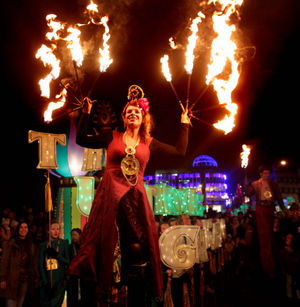
In some areas, people also take note of the wind direction as the New Year begins. If it comesfrom the west, then Ireland could look forward to a good year, but if it came from the east then things would be bad, and all the good luck would go to Britain instead.
One of the more unusual of Ireland’s traditions involves banging the walls of the house with bread as a way of chasing away bad luck and evil spirits. Some believe’s a way of encouraging good luck and ensuring there would be plenty of bread available over the coming year.
Wearing red underwear – Italy
According to folklore this dates back to the Middle Ages when people were not allowed to wear red garments, because the colour was associated with blood, the devil, witchcraft and evil forces.
But according to the legend women who wore red underwear during New Year’s Eve had good luck in love on the following year.
Italians have a tradition of wearing red underwear to ring in the new year and as the colour red is associated with fertility, and people wear it under their clothes in the hopes that it will help them conceive in the coming year.
But there are conditions – they should be received as a present and should be thrown away the following day.
After Christmas shops in Italy are full of red underwear ready for people who want to carry on the tradition.
The New Year’s meal is also full of superstition and will include lentils symbolising wealth and prosperity.
There’s also sausage meat, replaced in some parts of Italy by stuffed pig’s trotters, which again means good fortune for the coming year, because it is a rich food symbolising abundance.
And to finish there will be grapes as these are said ensure people will be frugal with any new-found wealth, because it was thought that only someone with excellent willpower could save the grapes from the spring harvest time until the New Year meal.

Remembering lost loved ones – Chile
In the South American country of Chile New Year’s Eve masses are held not at churches, but in cemeteries to include family members who are no long with us to be part of the festivities.
This tradition began in 1995 when a family in the small town of Talca, jumped the cemetery fence to spend the New Year near their father’s grave.
Rather than throw them out, the local authorities took a pragmatic view and decided that the practice should be encouraged, not stopped.
They now ensure the cemetery gates remain open at this time of year so that people can commemorate their lost loved ones in different ways.
For some it’s enough to be by the graveside in quiet reflection while others prefer to make it more of a celebration with food.
Every more than 5,000 people will head to the local cemetery every year, ambient with dim lights and classical music, where they believe their deceased relatives await them and are at peace knowing they are there.
Those who take part in the tradition also believe it’s an important part of the grieving process and helps them to recognise that life is valuable and needs to be enjoyed.



